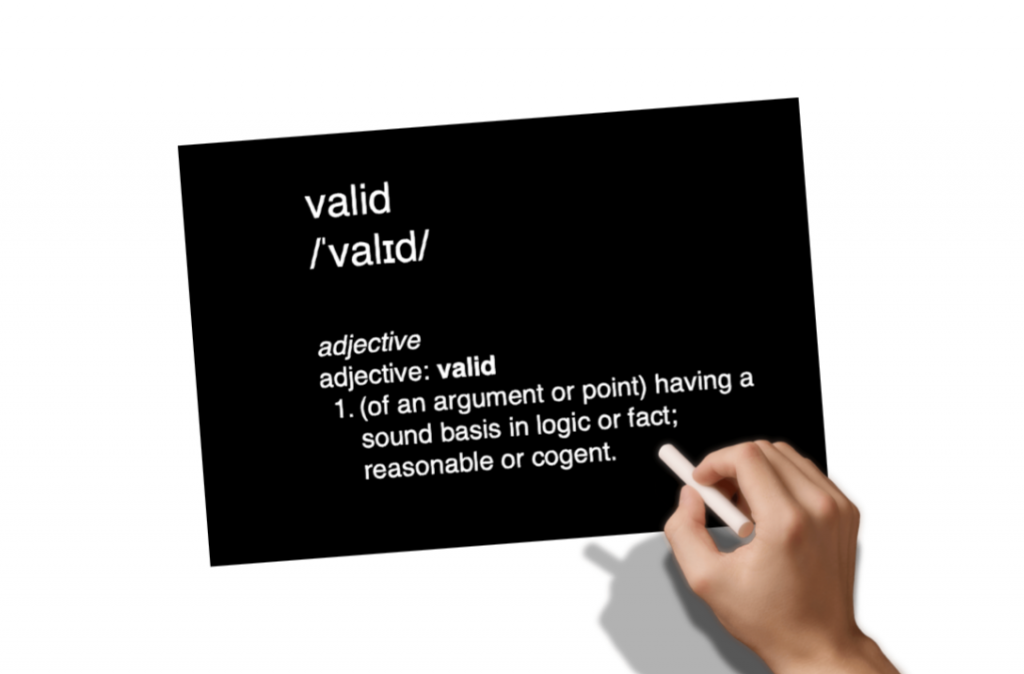
That an intelligent adult can keep a straight face when confronted with the idea that a special few of us are non-binary is one of the most astonishing things about the power of gender ideology.
A person who is non-binary feels themselves to be neither male nor female. Or possibly both. A cool and catchy word for non-binary is ‘enby’. Enby’s don’t like ‘he/him’ or ‘she/her’ pronouns and ofter use ‘they/them’ or ‘zie/zir’ although there are other options. Google is your friend.
A gender fluid person is something slightly different . Zie sometimes feels like a woman; sometimes feels like a man. A gender fluid person’s pronouns may change from moment to moment so be sure to check every time you speak to them in order to avoid the crime of misgendering.
How do we deconstruct this? Well another, slightly less catchy way of putting it would be ‘person-who-rejects-the-gendered-stereotypes-of-their-culture’. When you put it like that, the enby banner includes a lot of us. There may be a few people whose presentation and behaviour is 100% masculine or 100% feminine under all circumstances, but most of us fit in somewhere between the two extremes. Nobody likes being stereotyped. If non-binary is ‘a thing’ then probably a good 80% of us fit the description. Which makes enbys very far from the oppressed and misunderstood minority that they would have us believe they are.
How did the non-binary carriage manage to hitch itself to the trans train? Non-binary is the ultimate in gender woowoo, undermining the already tenuous position held by the concept that man and woman are feelings inside our heads.
If it’s surprising that the public seems willing to go along with this suggestion, it’s even more astonishing that the ‘trans community’ has taken it on board.
The idea that a man might believe he feels like a woman to the extent that he actually believes himself to be one is at least a concept most of us can understand, however much the logic behind it may be relatively incomprehensible.
The idea that somebody is neither male or female because they don’t like the stereotypes associated with either sex is absurd. It also opens up a lot of questions that nobody seems willing to answer.
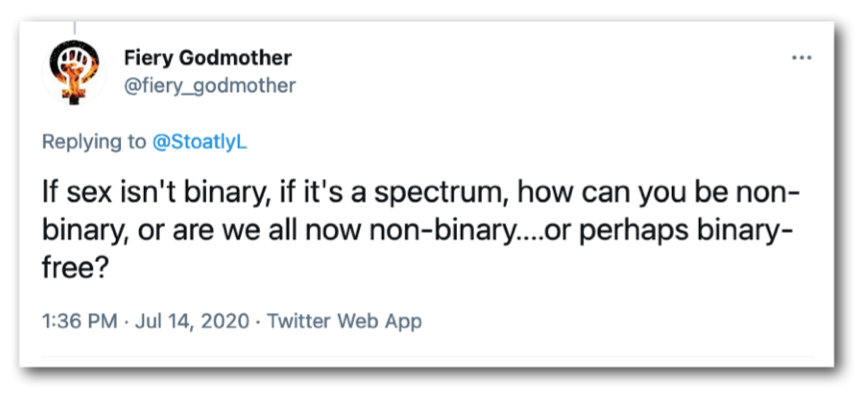
Those who identify as non-binary view themselves as the people in-the-middle, rising above the rest of us mere shallow and superficial men and women.
The idea that the rest of us are expected to go along with this is quite frankly, passive-aggressive, tyrannical bollocks.
 “Non binary is valid’ is quite possibly one of the most empty mantras ever taken on by a movement.
“Non binary is valid’ is quite possibly one of the most empty mantras ever taken on by a movement.
If there is one thing non-binary isn’t, it’s ‘valid’. The very phrase ‘non binary is valid’ doesn’t even make sense.
Let’s have a look at the dictionary definition of valid (see above).
Having a sound basis in logic or fact? Well no, obviously not.
Reasonable? “Having sound judgement; fair and sensible?” Je crois que non.
Cogent? “Clear, logical and convincing?” Excuse me while I check with my unicorn.
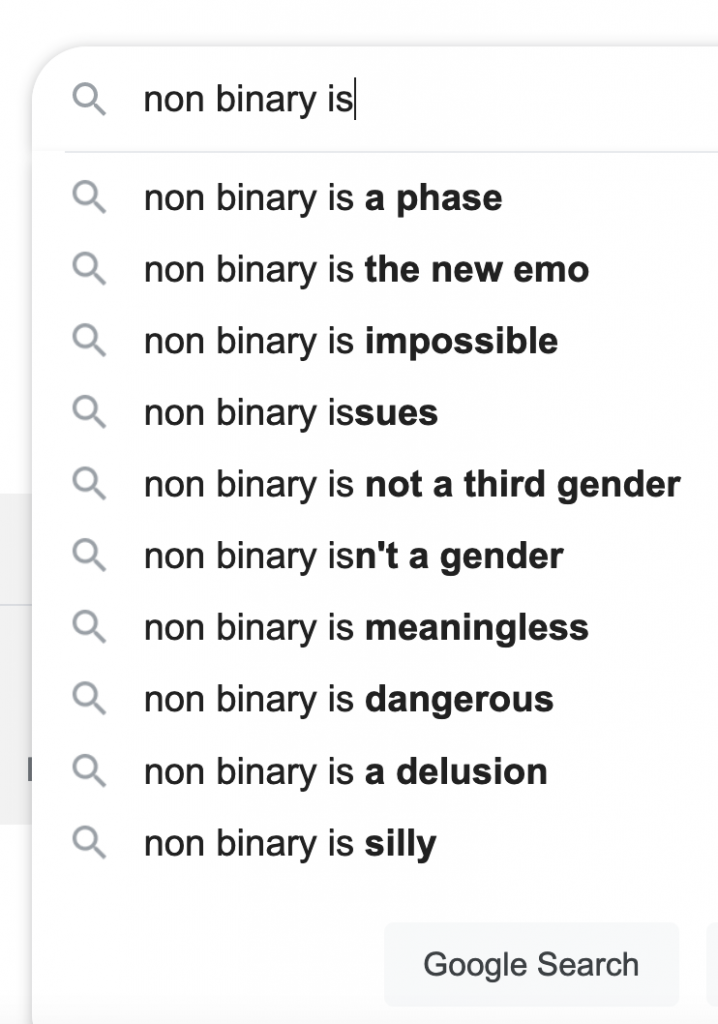
If gender ideology is a Christmas tree, non binary is the angel on top. If gender is a cup cake, non-binary is the cherry.
The reality is that most people realise this: a quick Google search starting ‘non binary is..’ threw up these options.
Yet nobody dares say so.
It has to be said, so I’ll say it.
Non-binary is bollocks.

You are not non-binary, because there is no binary.
In sex, there is a binary but in gender there is no binary.
In gender there are only stereotypes of expected behaviour. There is ‘boy’ behaviour and ‘girl’ behaviour, ‘man’ behaviour and ‘woman’ behaviour.
In the UK (as in most of the rest of Europe & America) we are very lucky because nobody is actually forcing us to comply with gendered behaviours. A girl can have short hair, a boy can have long hair and the world doesn’t end.
Until very recently, nobody felt the need to label themselves non-binary because they rejected gender stereotyping. So why are we now pushing people into boxes while pretending we’re doing the opposite? Our bodies are sexed. Within that there are numerous ways to express our personalities and some of these ways are by choosing clothing and expressing behaviours which are considered gendered.
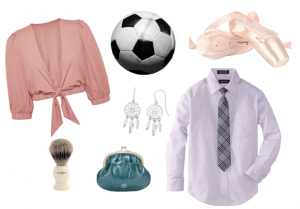
Take a look at the objects on the left. You can probably tell at a glance which are ‘for men’ and which are ‘for women’.
Now take a look at the ones below. These are a little harder, so imagine you’re on a game show. The general public have already cast their votes and you’re trying to give answers that agree with theirs. Imagine that you win £50 for every object you ‘correctly’ identify as being for either men or women.

You could probably make a pretty safe bet at getting them all right, yes? Which is pretty crazy, because men wear glasses and bracelets, use vases and most have owned a teddy bear or a pair of funky socks at some point. Women have briefcases, wear trainers and play cards, and go on boats. Did we agree? We probably did.
So gender is quite definitely weird. And the more we gender products, the more we ‘other’ boys and girls, men and women, for deviating from the gendered items aimed at them, the more we reinforce the walls of our gender boxes.
If you wouldn’t be seen dead in a frilly pink blouse it doesn’t mean you’re not a woman. If you hate football, it doesn’t mean you’re not a man. And more importantly if you like – or hate- both, it doesn’t make you non-binary. It just makes you someone who doesn’t want to perform gender stereotypes, and that’s just fine.
And it isn’t just the kids who seem to have trouble grasping this. I offer up these next two photos as examples of how the grown ups have left the room.
Adults & the enby
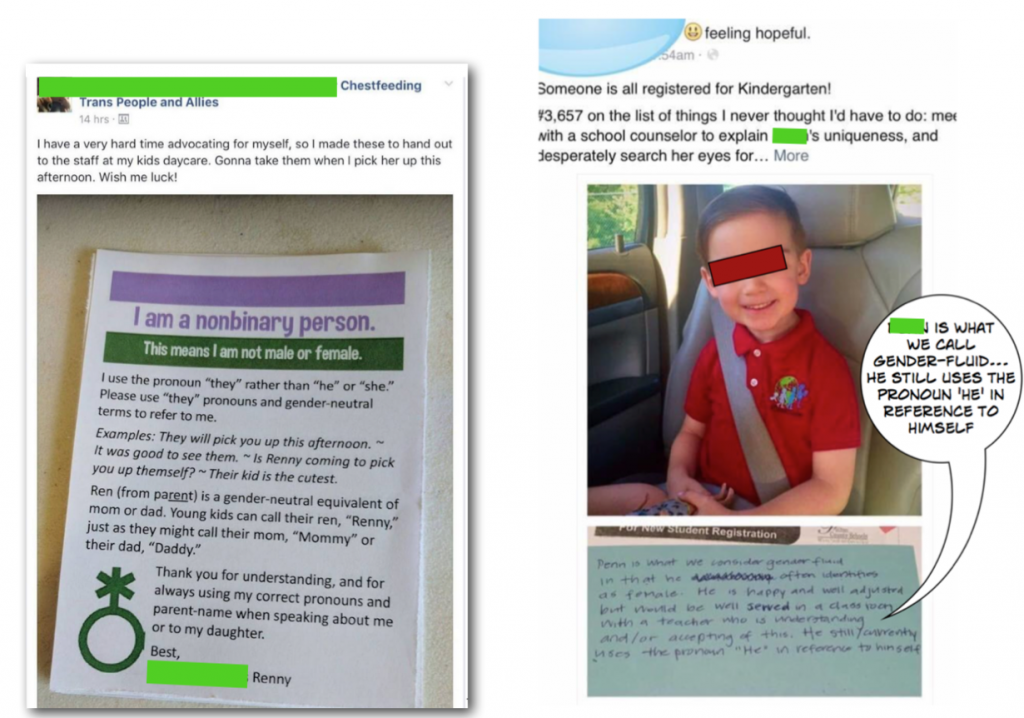
In the first we see a parent who evidently has ‘a very hard time advocating for myself’ demanding that teachers refer to her as ‘ren’ (from paRENt) instead of ‘mommy’ or ‘daddy’ and giving examples of how to use her pronouns: she suggests: ‘their kid is the cutest’.
In the second we see a parent who refers to her boy child as a girl ever though she writes that ‘he still uses the pronoun ‘he’ to refer to himself’. First day of kindergarten and she’s meeting with a school counselor to explain how unique her ‘gender fluid’ child is.
The Machiavellian manipulation of others here is intense, whether it is inadvertent or not. Are we really supposed to take this seriously?
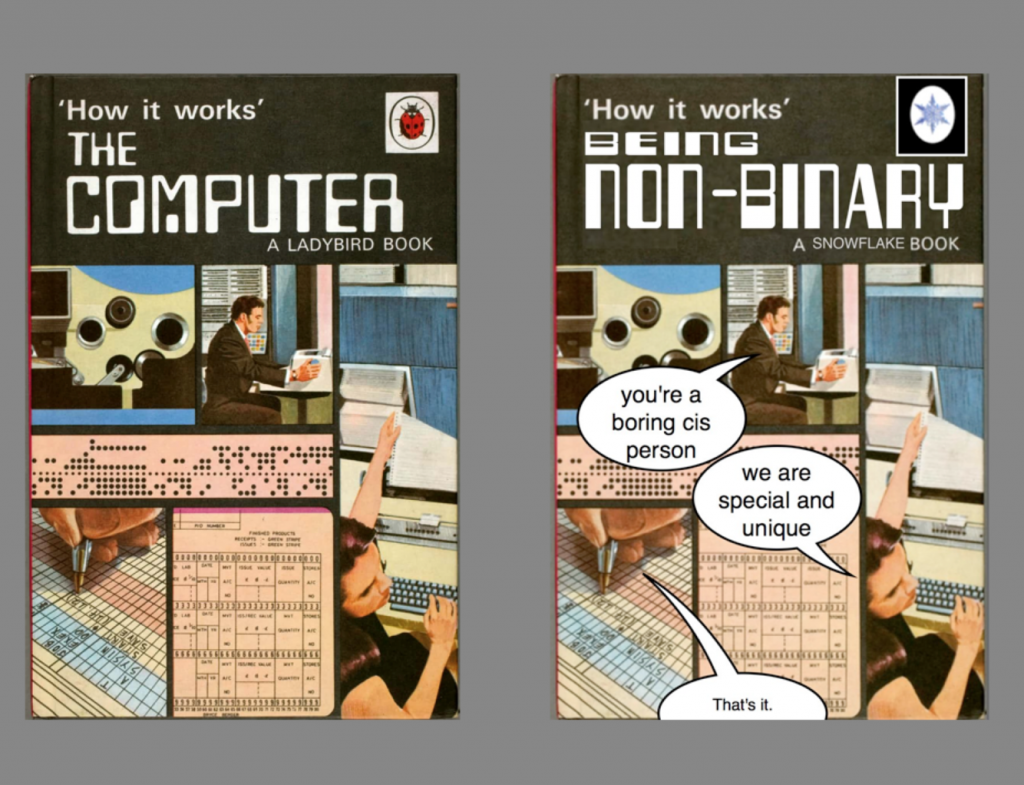
Lego & the little enby
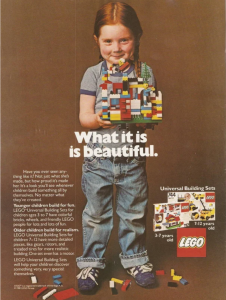 The marketing of Lego is a prime example of how gender stereotyping has been thrust upon a generation of kids. Most of us have seen this advert from the 80s. Rachel Giordano, the iconic 80s Lego girl, had this to say in a 2014 interview:
The marketing of Lego is a prime example of how gender stereotyping has been thrust upon a generation of kids. Most of us have seen this advert from the 80s. Rachel Giordano, the iconic 80s Lego girl, had this to say in a 2014 interview:
“…gender segmenting toys interferes with a child’s own creative expression. I know that how I played as a girl shaped who I am today. It contributed to me becoming a physician and inspired me to want to help others achieve health and wellness… Doctor kits used to be for all children, but now they are on the boys’ aisle.”
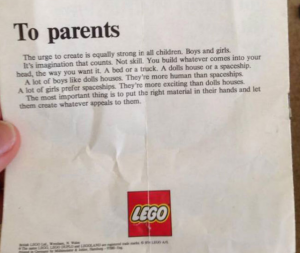 A note to parents from a 1974 Lego set read: “To Parents. The urge to create is equally strong in all children. Boys and girls. It’s the imagination that counts. Not skill. You build whatever comes into your head… a lot of boys like dolls houses. They’re more human than spaceships. A lot of girls prefer spaceships. They’re more exciting than dolls houses. The most important thing is to put the right material in their hands and let them create whatever appeals to them.”
A note to parents from a 1974 Lego set read: “To Parents. The urge to create is equally strong in all children. Boys and girls. It’s the imagination that counts. Not skill. You build whatever comes into your head… a lot of boys like dolls houses. They’re more human than spaceships. A lot of girls prefer spaceships. They’re more exciting than dolls houses. The most important thing is to put the right material in their hands and let them create whatever appeals to them.”
This message has got lost along the way.

Why am I going on about Lego now, especially when I’ve already covered the sexism rife in kids toys and clothing in my 2019 post ‘The Gendered Child’?
Because the rise of the ‘non-binary’ teen and twenty-something is directly linked to the gendered norms we have pushed onto kids in the last 20 years.
There weren’t kids declaring they were non-binary in the 80s because although we had stereotypes, most kids weren’t forced down those paths. Even if their parents pushed stereotypes onto them, advertising tried to avoid it, at least some of the time.
 Lego has recently released an ‘everyone is awesome’ box set for Pride 2021. It features mini figures in the pink blue and white colours which are now the symbols of the trans movement – white symbolises the enbys. There the figures are, all lined up in a neat little row. If the kids don’t like stereotypes, there’s another box they can fit themselves into.
Lego has recently released an ‘everyone is awesome’ box set for Pride 2021. It features mini figures in the pink blue and white colours which are now the symbols of the trans movement – white symbolises the enbys. There the figures are, all lined up in a neat little row. If the kids don’t like stereotypes, there’s another box they can fit themselves into.
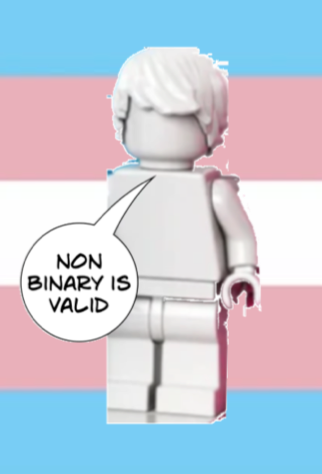 Yes, Lego, probably the 20th century’s most inclusive toy- now celebrates the idea of the Enby.
Yes, Lego, probably the 20th century’s most inclusive toy- now celebrates the idea of the Enby.
Is this really progressive?
Advertising & the teenage enby
With the advent of mass advertising, mass internet access, and ubiquitous TV has come the incessant and insidious drip of how men and women are ‘supposed to be’. According to advertising and marketing this is just one glorified endless stream of stereotypes.
In the world of advertising perfume, sex sells. The male is the predator and the female, the younger the better, is the prey.
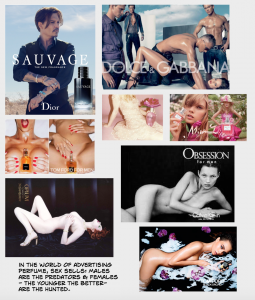
But what if you don’t feel like hunter or hunted?
What has happened to the middle path?
It’s become non-binary.
Wikipedia tells us this: “Non-binary (also spelled nonbinary), or genderqueer, is a spectrum of gender identities that are not exclusively masculine or feminine.”
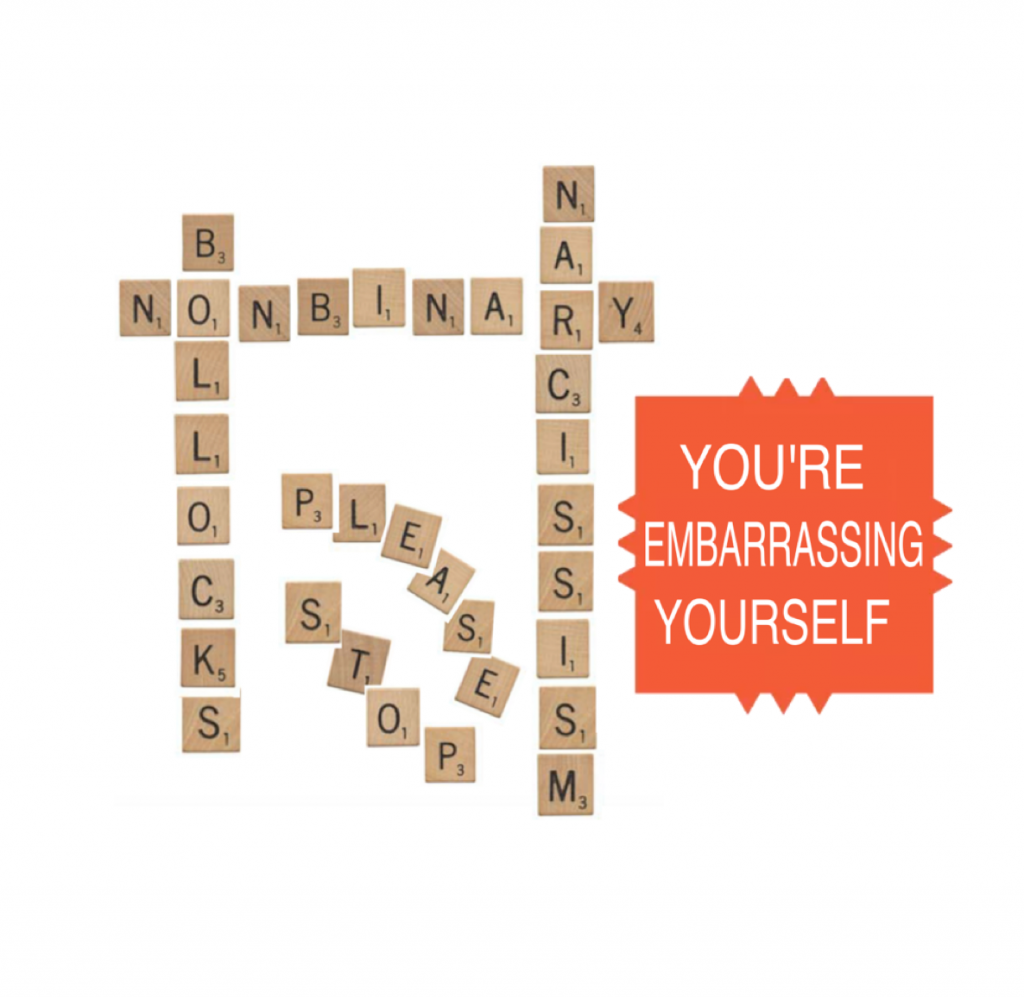 The National Centre for Transgender Equality tells us this: “some people have a gender that blends elements of being a man or a woman, or a gender that is different than either male or female. Some people don’t identify with any gender. Some people’s gender changes over time… an experience of gender that is not simply male or female.”
The National Centre for Transgender Equality tells us this: “some people have a gender that blends elements of being a man or a woman, or a gender that is different than either male or female. Some people don’t identify with any gender. Some people’s gender changes over time… an experience of gender that is not simply male or female.”
The LGBT Foundation tells us:“Non-binary people feel their gender identity cannot be defined within the margins of gender binary. Instead, they understand their gender in a way that goes beyond simply identifying as either a man or woman… having a gender which is in-between or beyond the two categories ‘man’ and ‘woman, as fluctuating between ‘man’ and woman’, or as having no gender, either permanently or some of the time.”
And, the ultimate in snowflakery:
“Understand that, for many non-binary people, figuring out which bathroom to use can be challenging.”
Scottish Trans adds: “Some people find they do not feel comfortable thinking of themselves as simply either male or female. Instead they feel that their gender identity is more complicated to describe… terms they have created to describe themselves include genderqueer, third-gender, bigender, androgyne, agender, gender-fluid and non-gender, although other terms are also used.”
Stonewall says: “Non-binary: an umbrella term for people whose gender identity doesn’t sit comfortably with ‘man’ or ‘woman’. Non-binary identities are varied and can include people who identify with some aspects of binary identities, while others reject them entirely.”
the non-binary bandwagon
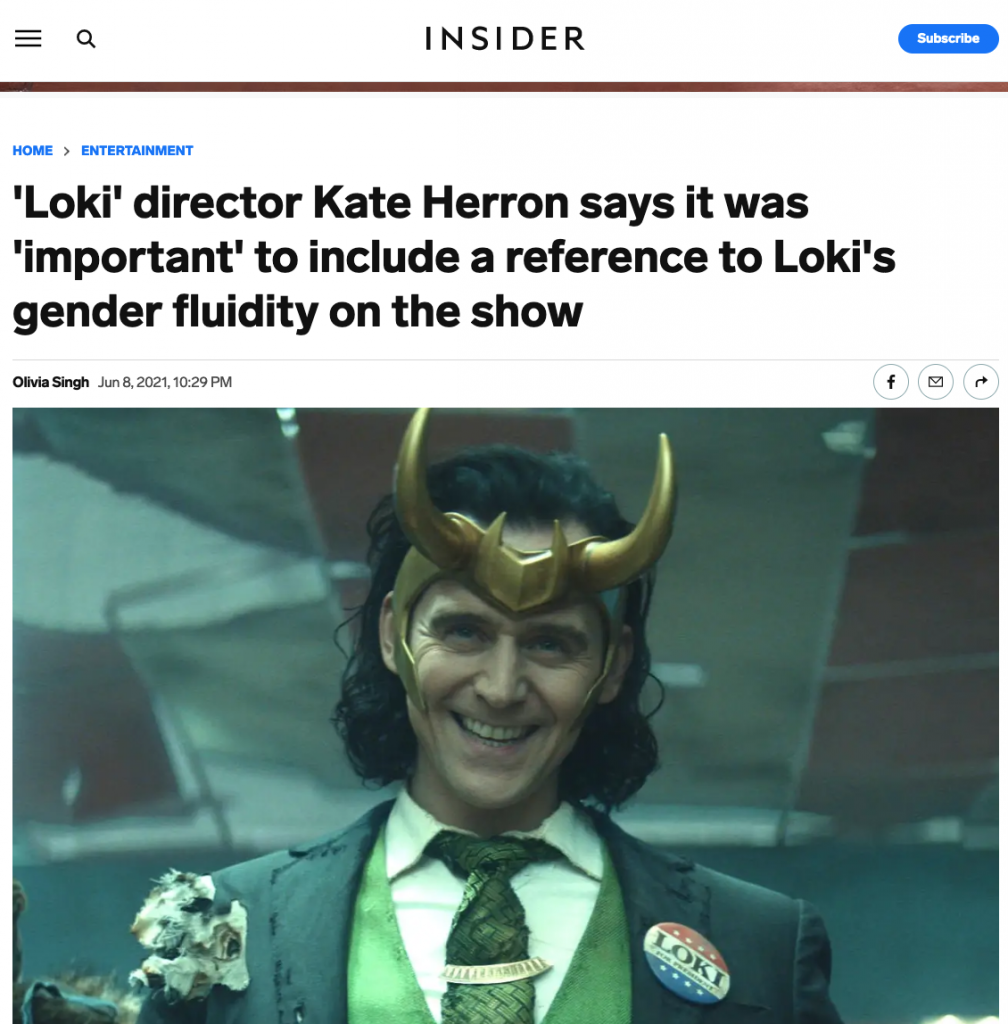 “A new teaser of the upcoming Disney+ series, Loki, has confirmed that the God of Mischief is part of the gender-fluid community!” gushed International News this week (June 2021), in a short article headlined ‘Loki’s non-binary identity confirmed in new Disney+ teaser’.
“A new teaser of the upcoming Disney+ series, Loki, has confirmed that the God of Mischief is part of the gender-fluid community!” gushed International News this week (June 2021), in a short article headlined ‘Loki’s non-binary identity confirmed in new Disney+ teaser’.
Shapeshifter Loki was evidently referred to both as a son and daughter by his father Odin in the comic book Thor & Loki: The Tenth Realm (2014). Director Kate Herron told the Insider that because of this it was important to recognise his gender fluidity and make it ‘cannon’.
 Now I’m all for ‘cannon’ and I am a massive comic book fan. I made myself highly unpopular on social media recently by trying to explain to a group of feminists who had never read the series that Desire in Sandman was literally non-binary.
Now I’m all for ‘cannon’ and I am a massive comic book fan. I made myself highly unpopular on social media recently by trying to explain to a group of feminists who had never read the series that Desire in Sandman was literally non-binary.
But wait, what is going on here? Is Loki non-binary or is he gender fluid? Even I know the two are not necessarily synonymous.
Thor seems less confused than his dad, referring to Loki as ‘son of… brother of mine… my brother’.
Will Thor now be cancelled for misgendering?
Most importantly, how will Loki manage his mischief if he can’t figure out which bathroom to use?
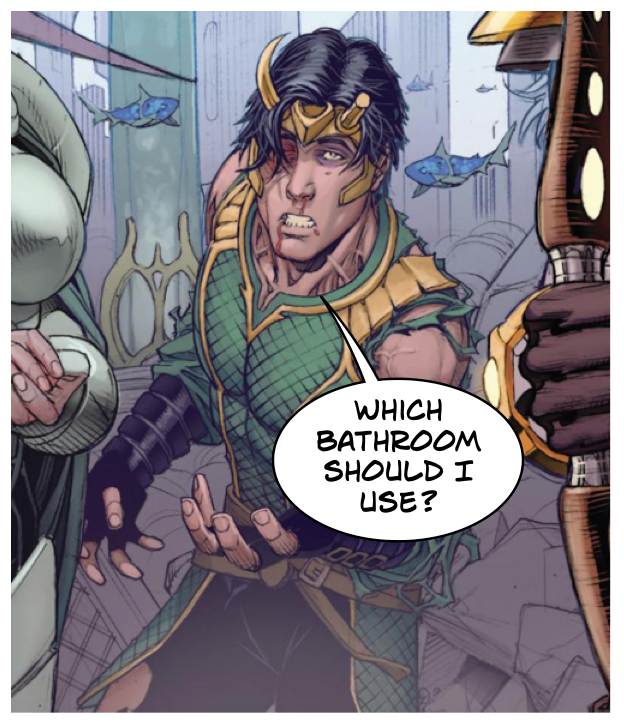
Most importantly of all – Loki is a shapeshifter and these characters are not real.
Back in reality, we need to ask what happens when all the cool role models have jumped ship? I nearly cried when Kae Tempest renounced her womanhood and I’m not a confused teenage girl trying to find my place in the world.
Will we end up in a world where a woman who doesn’t want to be objectified, sexually abused and treated like an idiot is forced to declare herself non-binary? How far can this idiocy go?
It seems that there is no end in sight. Most recent in a stream of celebs to announce a non-binary status is actor Demi Lovato who announced her they/them pronouns on Instagram in May. “So proud of you! So excited! You’re incredible!” squealed her young fans.
“Still, Demi said they’re going to continue to dress the way they wants to,” reports Seventeen magazine, a publication aimed at teenage girls, in an article titled ’13 Amazing Non-Binary Celebs Who Are Breaking the Gender Mold’.
“There might be a time when I want to wear a full wig,” said Demi.“There might be a time when I want to dress completely femme-presenting and that doesn’t mean that in that moment I’m identifying as a woman, it just means that’s what I want to wear in that moment.”
In the same article, Jonathan Van Ness- who is evidently non binary but prefers he/him pronouns- is quoted as saying “Like, some days I feel like a man, but then other days I feel like a woman… I’ve been wearing heels and wearing makeup and wearing skirts and stuff for a minute, honey. I just like didn’t know that that meant — that I had a title.”
“I identify as both non-binary and pansexual, which are two very fancy ways of saying I don’t care.” says Lachlan Watson, who plays Susie/Theo in The Chilling Adventures of Sabrina.
But all this woowoo is disingenuous. Declaring yourself to be non-binary is playing the ultimate ‘special’ card. It shows you care very, very much about being ‘not like the other girls’. In order for you to be non-binary, it is completely essential that others remain firmly in the binary box.
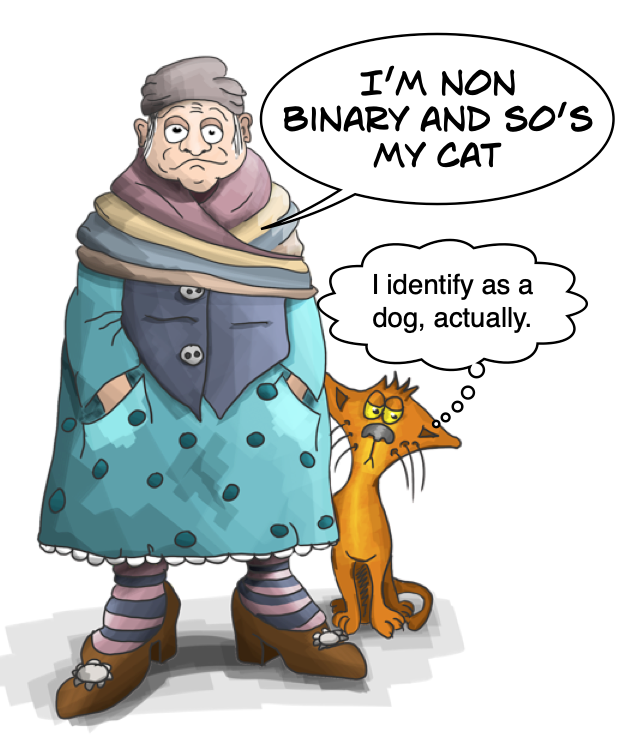 Perhaps we should start a middle-aged non-binary revolution. After all, the best way to get kids to stop doing something they think is cool and edgy is for the grown ups to start doing it too. The older the better! After all, ageism is the last -ism that is still culturally acceptable.
Perhaps we should start a middle-aged non-binary revolution. After all, the best way to get kids to stop doing something they think is cool and edgy is for the grown ups to start doing it too. The older the better! After all, ageism is the last -ism that is still culturally acceptable.
Imagine if pensioners started calling out the driver for misgendering them on a busy bus.
“This lady would probably like to sit down. Could one of you schoolkids give her your seat?”
“How dare you, young man! I identify as a pansexual demi-boy and my pronouns are zie/zir!”
Come to the dark side
I’m joking but I’m also not joking. There is a really dark side to this. There are casualties in this game. For some young people the idea of being non-binary is a gingerbread house in the forest of gender stereotypes. Encouraging young people to believe they are something they are not, that they are neither boys nor girls because they don’t like stereotypes, is going to result in inevitable mental health issues – the effort necessary to maintain such cognitive dissonance can be exhausting.
If you can stomach it, check out the ‘neutrois’ website, recommended by Mermaids.
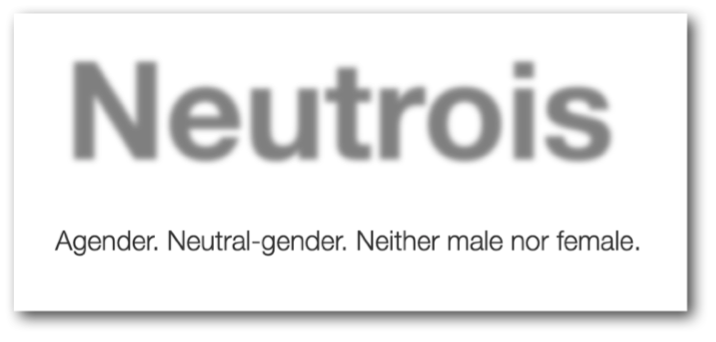 The homepage asks the question ‘Am I neutrois?’ with the quick reply:
The homepage asks the question ‘Am I neutrois?’ with the quick reply:
“Only you can know the answer to that, but don’t be disappointed if you’re not sure right away.“
The criteria for being neutrois are pretty basic. You don’t need to be dysphoric to be neutrois, and ‘don’t fret’ if you aren’t upset as being seen as the sex you are: “you are no more or less neutrois than somebody who feels completely genderless… It’s up to you and you only to make your own unique transition path… Many neutrois people do want surgery, many do not. The most common point of discomfort is breasts, for which neutrois people often seek top surgery…“
Middle-child has a nineteen-year-old friend who calls herself non-binary. She doesn’t want to be a boy, she just doesn’t want to be a girl. She got her date for an elective double mastectomy this week. She calls it ‘top surgery’ and she just can’t wait.
Meanwhile adults in positions of authority, journalists and those who should know better are egging kids on.
“I do identify as a woman, but I also identify as non-binary,” the ever-eloquent Suzanna Weiss explains in Teen Vogue. “To me, it means that I reject the whole concept of gender. Growing up, I never felt people were wrong when they called me a woman, but it felt like a label imposed on me rather than one that fit.”
Oh Suzanna, bless your little cotton socks. That doesn’t make you non-binary. It makes you gender critical. You may not realise it, but you get it. Gender is indeed imposed upon us. You may well not like being labelled with the stereotype sticker-gun. But that doesn’t make you a special snowflake. It makes you just like everyone else.
Sorry about that.
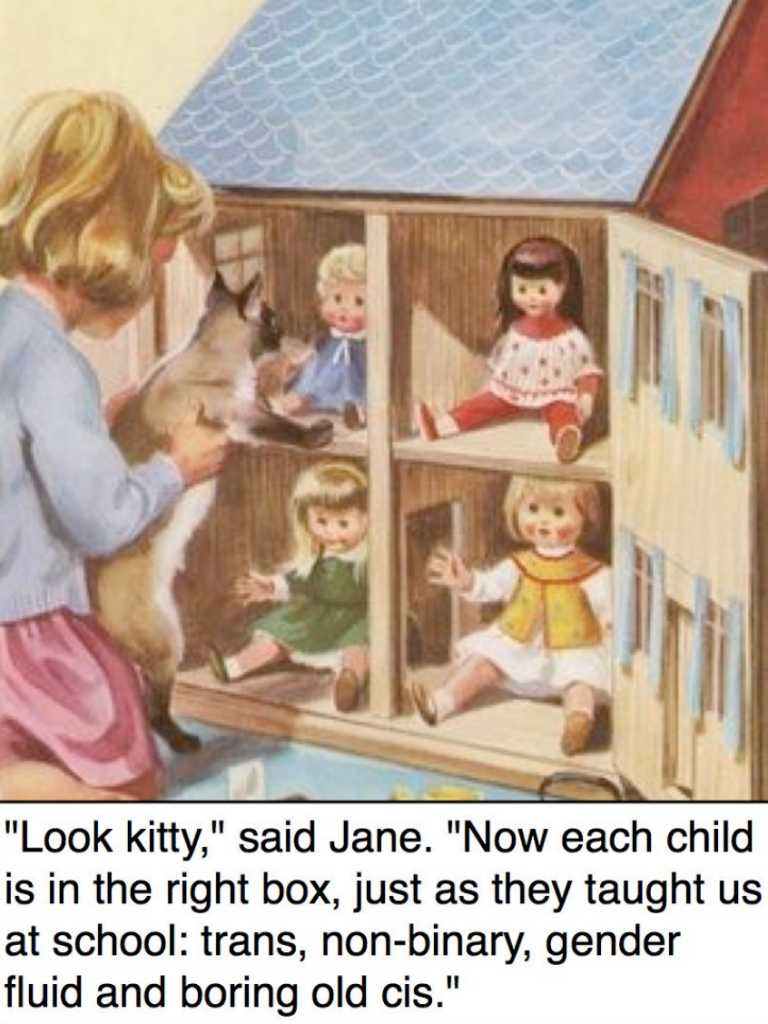

*Thank you!*
I have been saying “I have no gender identity” for years now.